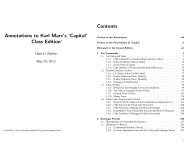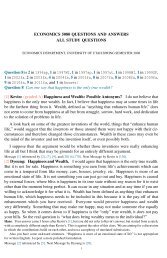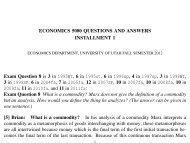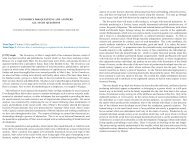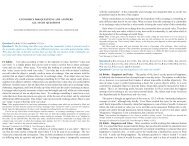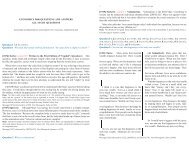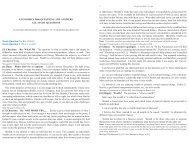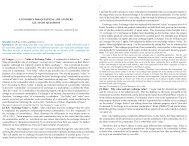Question 1 What did Marx mean with his formu - University of Utah
Question 1 What did Marx mean with his formu - University of Utah
Question 1 What did Marx mean with his formu - University of Utah
You also want an ePaper? Increase the reach of your titles
YUMPU automatically turns print PDFs into web optimized ePapers that Google loves.
U <strong>of</strong> <strong>Utah</strong> Econ 5080 2007fa 95<br />
There are many different determining factors that help one decide what to do <strong>with</strong> their<br />
commodities, some <strong>of</strong> which the commodity owner are unaware <strong>of</strong>.<br />
A commodity is mysterious because one needs the powers <strong>of</strong> abstraction to grasp them,<br />
<strong>mean</strong>ing that when you look at a commodity, there is a lot more to it than what initially<br />
meets the eye. There are many underlying factors that have made that commodity what it is;<br />
human labor, environmental factors, different uses, etc.<br />
Hans: Here you are only talking about the production <strong>of</strong> the use-value. For t<strong>his</strong> use-value to be a commodity you<br />
need private production, the equalization <strong>of</strong> labor, equal rights on the market place etc.<br />
And there are many more possibilities <strong>of</strong> what one can do <strong>with</strong> the commodity. Take an<br />
article <strong>of</strong> clothing for example, let’s say a shirt. When you first look at it you just see shirt.<br />
You notice the color, the style, possibly the material. But when you take time to analyze the<br />
shirt and think about what went into making it, or what options you have <strong>of</strong> using it, your<br />
possibilities are limitless.<br />
Hans: Again you are looking too much at the use-value <strong>of</strong> the commodity and not the social relations <strong>of</strong> which<br />
the commodity is the material expression. Perhaps you could have said at t<strong>his</strong> point that it is an organization <strong>of</strong><br />
production which does not specify which use-values are necessary for the survival <strong>of</strong> society, but everything is<br />
guided by market success.<br />
You have to take into account that the shirt was made maybe in a factory, where they<br />
could use child labor.<br />
Hans: Now you are talking. The relation between you and the producer is shrouded by the commodity, you don’t<br />
know whether the gleaming thing on the shelf is produced by child labor or under other oppressive conditions.<br />
There are many different materials that are used to make the shirt. The fabric it is made<br />
out <strong>of</strong>, the thread used to sew it together, etc. It becomes a lot more complicated now. And<br />
the mystery comes from what you can do <strong>with</strong> the shirt. <strong>What</strong> outfits that you can come up<br />
<strong>with</strong>, different ways to embellish the shirt, other uses for the shirt other than as a clothing<br />
item, etc. Once you take all <strong>of</strong> t<strong>his</strong> into consideration a commodity can be complicated<br />
and/or mysterious.<br />
Hans: You have to distinguish more consciously between those properties the commodity has as a use-value, and<br />
those which come from the social relations in a commodity society.<br />
Next Message by Amy is [133].<br />
[107] Jeff: Complicated and Mysterious. When considering <strong>Marx</strong>’s argument in the<br />
beginning <strong>of</strong> t<strong>his</strong> section, he attempts to realize where the value <strong>of</strong> the commodity really<br />
is located. He uses the example <strong>of</strong> the wood before being turned into a table. Before the<br />
manufacture <strong>of</strong> the table, the piece <strong>of</strong> wood was not seen as an important commodity. Its<br />
value became apparent only after it had been made into a table. All that happened is the<br />
form <strong>of</strong> the wood has changed. Intrinsically the piece <strong>of</strong> wood has not changed at all. <strong>Marx</strong><br />
also says that the table does not have unusual qualities (i.e. the capability to move on its<br />
own) which it acquired only after it was made, also leading to the question <strong>of</strong> where is t<strong>his</strong><br />
value acquired from. Therefore, he attempts to analyze where the value comes from. T<strong>his</strong> is<br />
the mystery he is referring to.<br />
When considering how a commodity becomes valued after it slightly changes form <strong>with</strong>out<br />
any change in intrinsic value, one would wonder if maybe its value is arrived at from its<br />
96 2007fa Econ 5080 U <strong>of</strong> <strong>Utah</strong><br />
instrumental value that it delivers. Neither the time nor the effort put into making t<strong>his</strong> commodity<br />
add to its value. But the result <strong>of</strong> all three components put together yield a valuable<br />
commodity. T<strong>his</strong> is the mystery that <strong>Marx</strong> discusses early on in <strong>his</strong> Fetis<strong>his</strong>m section.<br />
Hans: With the example <strong>of</strong> the table <strong>Marx</strong> tried to illustrate that the use-value <strong>of</strong> the commodity is not mysterious<br />
– because the production <strong>of</strong> the table as a use-value only changes the form <strong>of</strong> a naturally existing object (wood). But<br />
the table becomes mysterious when it is a commodity, i.e., produced for sale. When it is exchanged, its use-value<br />
becomes the measure <strong>of</strong> value for other commodities. T<strong>his</strong> is what <strong>Marx</strong> <strong>mean</strong>s <strong>with</strong> the table standing on its head<br />
in relation to other commodities. Another example might be: for a furniture business the table becomes part <strong>of</strong> their<br />
capital which needs to make pr<strong>of</strong>its. (But <strong>Marx</strong> has not yet introduced capital, that’s why he does not bring t<strong>his</strong> as<br />
an example here.) The mysterious aspects <strong>of</strong> commodities have to do <strong>with</strong> their value and exchange relations, not<br />
<strong>with</strong> their use-values.<br />
Message [107] referenced by [109]. Next Message by Jeff is [126].<br />
[109] Hans: Mystery <strong>of</strong> the Commodity. Although Jeff says otherwise in [107], there<br />
is no mystery in <strong>Marx</strong>’s mind about the source <strong>of</strong> value. In <strong>his</strong> theory, commodity prices<br />
come from labor content. Here <strong>Marx</strong> differs from mainstream economics, which says that<br />
commodity prices come from the marginal utility <strong>of</strong> the consumers. In <strong>Marx</strong>’s theory, the<br />
utility <strong>of</strong> a commodity determines how much <strong>of</strong> the commodity will be produced, but it does<br />
not determine the price.<br />
The mystery, for <strong>Marx</strong>, is rather: if the market rewards the producers for their labor, why<br />
do they not know t<strong>his</strong>? Why do they think the value <strong>of</strong> the commodity somehow comes out<br />
<strong>of</strong> the commodity itself and not from their labor? Jeff wrote expressly: “Neither the time<br />
nor the effort put into making t<strong>his</strong> commodity add to its value.”<br />
Our social relations are not transparent to us. T<strong>his</strong> is a problem. If we do not see what is<br />
going on in society, we are not the masters <strong>of</strong> our own relations, but the pawns.<br />
Next Message by Hans is [113].<br />
[115] Chris: An oasis <strong>of</strong> relations. The mystery for <strong>Marx</strong> is not the use-value, which<br />
is something “obvious and trivial” as we can view t<strong>his</strong> as something that satisfies needs in<br />
itself or becomes t<strong>his</strong> through human labor. We can understand t<strong>his</strong>, as <strong>Marx</strong> says, as when<br />
altering a piece <strong>of</strong> wood into a table, it has changed but it is tangible, we can see it and touch<br />
it.<br />
The mystery also does not arise from the determinants <strong>of</strong> value such as labor, quantity <strong>of</strong><br />
labor and such. So where does t<strong>his</strong> “mystery” arise from?<br />
The mystery lies in the fact that commodities reflect back an objective reality that is<br />
not controlled by the producers, the social relationships <strong>with</strong>in commodities can take on<br />
many forms. <strong>Marx</strong> uses the example <strong>of</strong> the eye and the light <strong>of</strong> an object, where the eye<br />
and the object have physical reality <strong>with</strong> each other, there is a physical reaction between<br />
the object and the eye. The commodity form <strong>of</strong> the products <strong>of</strong> labor, and the value <strong>with</strong><br />
which it represents itself does not involve itself <strong>with</strong> the physical properties or itself as a<br />
physical object. It is therefore the interactions between people that give commodities a<br />
relationship between themselves. T<strong>his</strong> is a weird idea that although commodities do have<br />
physical properties and can be objects such as a table, it is not these physical properties that<br />
wholly determine them but the social relations between people in society.<br />
Next Message by Chris is [195].



